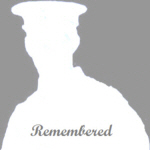



No.49148, Private, Herbert HARVEY
Aged 37

|
Herbert Harvey was born in Isleham in 1880 (Newmarket Q2-1880 3B:592), son of John and Ellen HARVEY (née PRITTY).
1881 census...Aged 0, he was at West Street, Isleham with his father John HARVEY [32] agricultural labourer; his mother Ellen[32] and sisters Ellen [7] and Ada [3], and brother John R. [5]. The whole family were Isleham born. 1891 census...Aged 10 he was still at West Street, Isleham with his parents, sister Ellen, brother John R., sisters Ada and Maud [5] and brother Alfred [2]. 1901 census...Aged 20, a non domestic groom, he was at Pound Lane, Isleham with his widower grandfather Robert PRITTY [79]. His parents, brother John R (farm labourer), sister Maud and brothers Alfred and Bertie were next door in Pound Lane. In 1906 he married Rebecca BUTCHER. 1911 census...Aged 30, a groom and domestic gardener, he was at Waterside Drove, Isleham with his wife [30](b.12-1-1881) and daughter Violet Maud [2] (b.23-7-1908), both born in Isleham. His parents, brothers Alfred and Bertie and Aunt Mary Ann PRITTY were still at Pound Lane.
The pension card initially has his widow and daughter at "The Goat Inn, Gorefield, nr Wisbech, but later at 19 Whiting Street, Bury St Edmunds.
|

|
Enlisted in Newmarket. July 31st 1917 saw the start of the 3rd battle for Ypres, the hell that was to become known as Passchendaele. Quite apart from some ferocious fighting the battle soon bogged down, a very appropriate term since it was the worst weather in Flanders for 75 years and the battle stalled until 10th August. From "The Royal Fusiliers in the Great War", by H C O'Neill OBE we learn that: " On August 10th the 11th Battalion took part in one of those minor operations which are the aftermath of all great battles ; and it was their fate to fight over much the same ground as that on which the 4th Battalion had clashed with the Grenadier Guard Regiment in the first Battle of Ypres. The Fusiliers, the right assaulting battalion of the 54th Brigade, had their right flank near the Ypres-Menin road ; and at 4.35 a.m. B Company on the left, D on the right, attacked from this position. They advanced steadily against little opposition until the machine-gun fire from Inverness Copse — in the neighbouring brigade area — brought up the right flank and made it swerve to the left. On the left, however, the men penetrated some distance into Glencorse Wood, despite the ten or twelve " pill-boxes " standing like sentinels on the edge, some 200 yards from the south-west corner of the wood. Some of D Company also got well forward and reached Fitzclarence Farm. ....As a natural consequence, a gap was made between the 11th Battalion and the brigade on their right. In less than two hours all the officers of the assaulting companies were casualties, and a counter-attack was initiated by the Germans. The Fusiliers were out of touch with the troops on both flanks ; and a skilful bombing attack down the Jargon and Jap Trenches rendered their position impossible to maintain. Issuing from Inverness Copse the Germans almost penetrated to the rear of (C) the support company. Despite the cool and courageous handling of the men by the N.C.O.'s the Fusiliers could only remain where they were at the imminent peril of envelopment. They were compelled to retire and establish themselves some 200 yards east of Clapham Junction, in touch with the 55th Brigade on the right. Some of the men were cut off, and one of them gave a good account of himself. Private Arthur Jakes remained calmly in an advanced shell-hole, sniping all the day, and at night found his way through the German lines back to his battalion. The 11th remained in their position until 4 a.m. on August 11th when they were relieved. They went back to Dickebusch huts weaker by 17 officers and 328 other ranks than when they entered battle." This day's work cost the 11th battalion 114 killed, of which just 15 have identified graves. |



photo; Commonwealth War Graves Commission
click here to go to the Commonwealth War Graves Commission website for full cemetery/memorial details